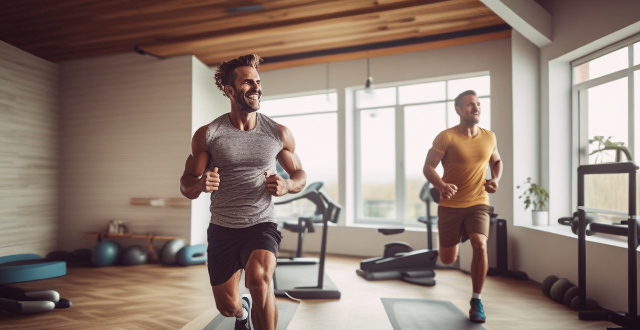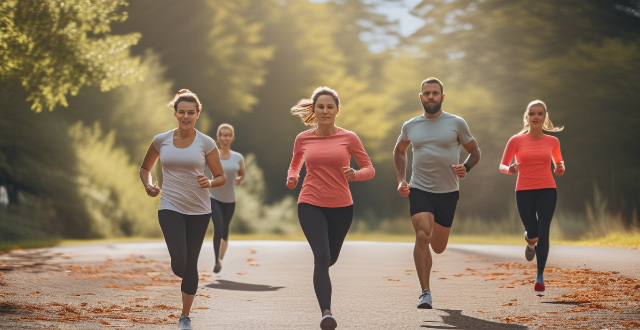Cardiovascular Levels

What role does cardiovascular exercise play in managing daily stressors ?
Cardiovascular exercise is an excellent way to manage daily stressors, as it reduces the body's physiological response to stress and leads to improved mental and physical health. The benefits of cardiovascular exercise include reduced stress levels, improved sleep quality, increased energy levels, and better mental health. To get started with cardiovascular exercise, set goals, start slow, find activities you enjoy, and mix up your workouts. Incorporating cardiovascular exercise into your daily routine can help you manage stress and improve overall well-being.

Can exercise reduce the risk of developing cardiovascular diseases ?
Cardiovascular diseases (CVDs) are a leading cause of death worldwide, and regular physical activity or exercise is one of the most effective ways to reduce the risk of developing them. Exercise helps improve blood circulation, lower cholesterol levels, reduce inflammation, manage weight, and improve glucose control. The American Heart Association recommends at least 150 minutes per week of moderate-intensity aerobic activity or 75 minutes per week of vigorous-intensity aerobic activity, along with muscle-strengthening activities at least two days per week.

Can climate change lead to an increase in cardiovascular diseases ?
The article discusses the relationship between climate change and cardiovascular diseases, highlighting how extreme heat events, changes in air quality, and extreme weather patterns can contribute to an increase in heart-related illnesses. It explains how dehydration and electrolyte imbalances caused by heat stress can strain the heart, leading to chest pain, shortness of breath, and even heart failure. The article also points out that rising temperatures can cause pollutants like ozone and particulate matter to become more concentrated in the air we breathe, irritating the lungs and reducing oxygen uptake, which can strain the heart. Additionally, extreme weather events like hurricanes, floods, and wildfires can have both direct and indirect effects on cardiovascular health by causing physical trauma, stress, lack of access to medical care, and disruptions in medication adherence and continuity of care for those with chronic cardiovascular diseases. The article concludes by emphasizing the importance of taking steps to protect cardiovascular health, such as staying hydrated during hot weather, monitoring air quality, and having emergency plans in place for natural disasters.

How much exercise do I need to maintain good cardiovascular health ?
Maintaining good cardiovascular health requires regular exercise, with the American Heart Association recommending at least 150 minutes of moderate-intensity aerobic activity or 75 minutes of vigorous-intensity aerobic activity each week, along with two or more days of muscle-strengthening activities. The amount of exercise needed may vary depending on individual needs and fitness level, and other lifestyle factors such as diet, stress management, sleep, and avoiding smoking and excessive alcohol consumption can also contribute to good cardiovascular health.

What is the difference between cardiovascular and resistance training in health management ?
The text discusses the differences between cardiovascular and resistance training, highlighting their unique benefits and examples of each. Cardiovascular training strengthens the heart, aids in weight management, and improves endurance, while resistance training enhances muscle strength, bone density, and metabolism. Combining both types of exercise leads to a well-rounded fitness regimen that addresses multiple aspects of health, including endurance, strength, flexibility, and balance. The text suggests ways to incorporate both forms of exercise into a workout routine for optimal health management.

How does exercise physiology explain the differences in fitness levels among individuals with different genetic backgrounds ?
Exercise physiology explores the interaction between genetic factors and environmental influences like exercise, nutrition, and sleep to explain variations in fitness levels among individuals. It examines how muscle fiber composition, cardiovascular efficiency, metabolic rate, and body composition affect one's ability to perform physical activities. While genetic background sets a baseline for fitness potential, lifestyle choices significantly impact an individual's actual fitness outcomes. By understanding these principles, individuals can optimize their fitness through targeted exercise training, proper nutrition, and adequate rest.

How does exercise improve cardiovascular health ?
This essay explores the ways in which exercise can improve cardiovascular health. It explains how regular physical activity strengthens the heart muscle, increases blood flow, and lowers blood pressure. The essay also discusses how exercise can reduce risk factors for cardiovascular disease, such as obesity, diabetes, and high cholesterol levels. Additionally, it highlights the positive effects of exercise on mental health and well-being, including stress reduction, depression management, and improved quality of life. Overall, the essay emphasizes the importance of regular exercise for a healthy lifestyle and encourages readers to incorporate physical activity into their daily routines.

Can family members of different ages and fitness levels do the same home workout ?
The question of whether family members of different ages and fitness levels can engage in the same home workout is a pertinent one, especially considering the numerous health benefits associated with regular exercise. The positive effects of physical activity on longevity and disease prevention are well-documented At the core of this inquiry lies the understanding that exercise, regardless of its form, be it running or weight lifting, significantly contributes to a longer and healthier life. Given the myriad benefits of regular physical activity, families are often inclined to incorporate workout routines into their daily lives. However, the variance in age and fitness levels among family members presents certain challenges and considerations:

Can aerobic exercise improve my cardiovascular health ?
Aerobic exercise is essential for maintaining and improving cardiovascular health, offering benefits such as strengthened heart muscle, lowered blood pressure, increased HDL cholesterol, reduced inflammation, weight management, improved circulation, and better blood sugar regulation. Regular aerobic activities like walking, jogging, cycling, swimming, or group fitness classes can significantly enhance overall heart health. The American Heart Association recommends at least 150 minutes of moderate-intensity aerobic exercise weekly, spread throughout the week, to achieve these benefits.

How do office layouts influence employee physical health and activity levels ?
This article explores the influence of office layouts on employee physical health and activity levels, discussing the benefits and drawbacks of open versus closed office designs, the importance of ergonomics in workstation design, and strategies for encouraging movement within the workplace. By considering these factors, employers can create environments that promote productivity while prioritizing employee well-being.

Are there any unique considerations for women's cardiovascular health ?
Cardiovascular disease is the leading cause of death among women globally, with unique considerations for their heart health. These include hormonal influences, menstrual cycle impact, pregnancy and postpartum changes, oral contraceptives, autoimmune diseases, polycystic ovary syndrome, lifestyle factors, symptom awareness and response, and preventive care. Recognizing these factors is crucial for improving prevention, diagnosis, and treatment strategies tailored specifically for female patients, ultimately reducing mortality rates from CVD.

What exercises are beneficial for women's health ?
Regular physical activity is crucial for women's health, preventing chronic diseases, improving mental health, and boosting self-esteem. Aerobic exercises like running, swimming, and cycling are great for cardiovascular health and weight management. Strength training exercises such as weightlifting, resistance bands, and bodyweight exercises can improve bone density and reduce the risk of osteoporosis. Yoga helps to improve flexibility, reduce stress, and enhance mental clarity, while Pilates focuses on core strength, flexibility, and balance. Incorporating these exercises into a fitness routine can lead to improved cardiovascular health, stronger bones and muscles, reduced stress levels, and enhanced overall well-being.

What are some examples of aerobic exercises ?
Aerobic exercises are physical activities that increase heart rate and breathing to deliver more oxygen to muscles, improving cardiovascular health, burning calories, and reducing chronic disease risk. Examples include using cardiovascular machines like treadmills and elliptical trainers, outdoor activities such as running and cycling, group fitness classes including aerobic dance and spinning, sports like basketball and tennis, and low-impact options like brisk walking and water aerobics. Benefits encompass improved heart health, weight management, increased stamina, mental health enhancement, and immunity boost. Safety precautions include consulting a healthcare professional, proper warm-up and cool-down, staying hydrated, and listening to your body to avoid overexertion.

Can regular physical activity reduce anxiety levels ?
Regular physical activity can help reduce anxiety levels by improving mood, reducing stress hormones, promoting better sleep, increasing self-esteem and confidence, and providing social support. Engaging in at least 30 minutes of moderate-intensity exercise per day can significantly reduce anxiety symptoms.

Why is it a mistake to believe that more exercise automatically leads to better health ?
The belief that more exercise automatically leads to better health can be a mistake due to several reasons such as overexertion and injury risk, neglect of other aspects of health, cardiovascular strain, hormonal imbalances, and mental health impact. It is important to recognize that more is not always better and a balanced approach that incorporates appropriate amounts of exercise along with attention to nutrition, rest, and overall wellness is key to achieving optimal health outcomes.

Can you explain the difference between biosafety levels 1-4 ?
Biosafety Levels (BSL) are guidelines for handling hazardous biological agents, with four levels of increasing risk and safety measures. BSL-1 is for non-pathogenic organisms, BSL-2 for moderate risk agents, BSL-3 for serious disease-causing agents, and BSL-4 for highly dangerous agents like Ebola. Differences include lab design, access control, safety equipment, and procedures to protect personnel and the environment.

How does the greenhouse effect impact ocean levels ?
The greenhouse effect, essential for Earth's habitThe greenhouse effect, essential for Earth's habittensified by human activities like has been intensified by human activities like burning fossil fuels and deforestation. This amplified effect is causing global warming, which leads to rising ocean levels through melting polar ice caps and thermal expansion of seawater. Changes in precipitation patterns also indirectly affect ocean levels by redistributing water. Addressing the causes of the enhanced greenhouse effect is vital to mitigate these impacts and protect the planet's future.

Are there specific workout routines designed for emotional stability ?
Emotional stability is an important aspect of overall well-being, and exercise can play a significant role in achieving it. Cardiovascular exercises like running, cycling, swimming, and dancing increase heart rate and blood flow, reducing stress and anxiety levels while releasing endorphins that improve mood. Strength training such as weightlifting or resistance band exercises build muscle strength and endurance, improving self-esteem and confidence while reducing symptoms of anxiety and depression by promoting the growth of new brain cells and increasing neurotransmitter levels. Yoga and meditation practices focus on mindfulness, breathing techniques, and relaxation, reducing stress levels and improving cognitive function, memory, and attention span. Incorporating these activities into your fitness routine can have a positive impact on your emotional stability and overall well-being.

Does strength training have an impact on stress levels ?
Strength training can have a positive impact on stress levels through both physical and psychological benefits. It increases endorphin release, improves sleep quality, enhances self-esteem, provides distraction from stressors, fosters a sense of accomplishment, and promotes mindfulness. Consult with a healthcare professional before starting any new exercise regimen.

What role does government regulation play in ensuring safe levels of radiation exposure for the public ?
Government regulation is essential for ensuring safe radiation exposure levels by setting standards, licensing facilities, conducting inspections, educating the public, investing in research, preparing for emergencies, and collaborating internationally to manage radiation risks effectively.

How do sports competitions influence stress levels and mental readiness ?
Sports competitions can significantly impact stress levels and mental readiness. Performance pressure, fear of failure, winning obsession, and physical exertion can increase stress levels, while confidence building, goal achievement, camaraderie, and mindfulness practices can decrease them. Similarly, focus and concentration, resilience, mental toughness, and visualization techniques can improve mental readiness, while overthinking, perfectionism, lack of self-belief, and external factors can impair it. Overall, sports competitions provide opportunities for growth, learning, and personal development but also present challenges that require effective coping strategies to manage stress levels and maintain mental readiness.

What are the impacts of climate change on sea levels ?
Climate change is causing sea levels to rise, which can have devastating consequences on coastal communities and ecosystems. The melting of ice sheets in Greenland and Antarctica, thermal expansion, loss of coastal wetlands, and increased erosion and flooding are all impacts of climate change on sea levels. It is essential to take action to mitigate the effects of climate change and protect our planet's ecosystems and communities from further harm.

What are the favorite exercises of popular celebrities ?
Celebrities have different preferences when it comes to exercise, but they all share a common goal of staying fit and healthy. Some popular exercises among them include yoga, Pilates, cardiovascular exercises, and weight training. Yoga is favored by Jennifer Aniston, Gwyneth Paltrow, and Madonna for its benefits on flexibility, strength, and balance. Pilates is preferred by Kim Kardashian, Vanessa Hudgens, and Kate Hudson for strengthening the core muscles and improving posture. Cardiovascular exercises like running, cycling, and swimming are enjoyed by Taylor Swift, Emma Stone, and Ryan Reynolds for burning calories and improving cardiovascular health. Weight training is popular among Dwayne "The Rock" Johnson, Chris Hemsworth, and Gal Gadot for building muscle mass and increasing strength. Overall, celebrities incorporate these activities into their daily routines to maintain their impeccable physique and overall well-being.

How has global warming impacted sea levels around the world ?
Global warming, primarily caused by greenhouse gas emissions from human activities, has significantly impacted sea levels. This includes melting glaciers and ice sheets, thermal expansion of ocean waters, coastal erosion, saltwater intrusion, increased flooding and storm surge risks, and displacement of coastal communities. Addressing these issues requires both mitigation efforts to reduce emissions and adaptation strategies to cope with the changes already underway.

How does exercise influence cortisol levels, which are associated with stress ?
Exercise has a complex relationship with cortisol levels and stress management. Acute exercise can cause a temporary increase in cortisol levels, while chronic exercise can help regulate them over time. By managing stress through regular physical activity, individuals can maintain healthy cortisol levels and improve their overall well-being. Chronic stress and persistently high cortisol levels can contribute to a range of health problems, including weight gain, high blood pressure, impaired immune function, decreased bone density, increased risk of heart disease and stroke, and mood disorders such as anxiety and depression. Regular exercise can help manage stress and maintain healthy cortisol levels by improving mood and mental health, better sleep quality, and increased resilience to stress.

How does exercising regularly impact stress levels and overall mood ?
This text discusses the impact of regular exercise on stress levels and overall mood. It highlights how physical activity can help reduce stress by releasing endorphins, regulating cortisol levels, improving self-esteem, and providing distraction from worries. Additionally, it explains how exercise enhances mood through immediate effects like increased energy and a feeling of achievement, as well as long-term outcomes such as better sleep and social interaction. The text concludes that regular exercise has a profound impact on mental well-being, promoting both looking good and feeling good.

How has climate change affected polar ice caps and sea levels ?
The polar ice caps are melting due to global warming, causing sea levels to rise and threatening coastal communities and ecosystems. The Greenland and Antarctic ice sheets are losing mass at an accelerating rate, contributing significantly to rising sea levels. This has significant implications for both the environment and human societies around the world. Rising sea levels pose serious threats such as coastal erosion, saltwater intrusion, loss of wetlands and mangrove forests, and displacement of coastal communities. To mitigate these impacts, urgent action must be taken to reduce greenhouse gas emissions and transition to cleaner energy sources.

Can exercise physiology help in managing stress and anxiety levels ?
Exercise physiology plays a significant role in managing stress and anxiety levels by promoting various physiological responses that counteract the negative effects of these conditions on the body. By incorporating regular physical activity into your lifestyle, you can improve your overall mental well-being and reduce the impact of stress and anxiety on your daily life.

How does wearing a face mask affect oxygen levels in the body ?
Wearing a face mask is an essential practice during the COVID-19 pandemic to prevent the spread of the virus. However, some people have concerns about whether wearing a mask affects oxygen levels in the body. In this article, we will explore how wearing a face mask affects oxygen levels in the body and provide evidence to support our claims. There are two main ways in which wearing a face mask can affect oxygen levels: decreased airflow and increased carbon dioxide retention. However, studies have shown that wearing a face mask does not significantly reduce oxygen levels in healthy individuals who are not exercising heavily. In healthy individuals, wearing a face mask does not pose any significant risk of low oxygen levels. However, if someone has underlying respiratory conditions such as asthma or COPD, they may experience shortness of breath or other symptoms when wearing a face mask. To ensure adequate oxygen levels while wearing a face mask, one can follow these tips: choose the right type of mask, maintain good hydration, exercise regularly, avoid heavy exercise, and consult with healthcare professionals if necessary.

How does urban vegetation impact air pollution levels ?
Urban vegetation, including trees, shrubs, and grasses in urban areas, plays a crucial role in mitigating air pollution. It improves air quality by reducing pollutants such as carbon dioxide (CO2), nitrogen oxides (NOx), and particulate matter (PM). Plants absorb CO2 from the atmosphere during photosynthesis, which helps to reduce the concentration of this primary greenhouse gas contributing to global warming. Trees also store carbon in their biomass, effectively removing it from the atmosphere through a process known as carbon sequestration. The large leaf surface area of urban vegetation helps to capture and reduce nitrogen oxides (NOx) in the air. When NOx comes into contact with plant leaves, it reacts with the stomata to form nitrates, which are then absorbed by the plant. Soil microorganisms play a vital role in breaking down organic matter and converting it into nutrients that plants can use. These microorganisms also help to reduce NOx levels by converting them into harmless compounds such as nitrogen gas. Urban vegetation can trap particulate matter (PM) through its leaves and bark, preventing it from being inhaled by humans and animals. This helps to reduce the health risks associated with PM exposure, such as respiratory problems and cardiovascular diseases. Trees act as wind breaks, reducing wind speed and preventing PM from becoming airborne, which helps to keep PM levels low in urban areas and improve overall air quality. In conclusion, promoting urban green spaces and encouraging the planting of more trees and shrubs in cities is essential to mitigate the negative effects of air pollution.